SMS Automation Definition, Types, Examples & Tools
It’s hard to find any business that didn’t have to pivot some aspect of their business strategy. The impact of COVID-19 spans across all industries, forcing business owners to find new ways of communicating with their customers or among each staff member.
Take the restaurant industry as an example. While many are forced to close to help flatten the curve of the pandemic, they still work hard to bring in revenue. For many restaurants, that means switching to a take-out or curbside model. It also adds convenience to many workers from home who want to grab food and get back to ongoing tasks while staying safe.
But how do they communicate the orders with their customers effectively, especially when a user receives much too many notifications and emails nowadays to pay attention to a food order? For many, the answer is SMS marketing.
People rely a lot on their digital devices nowadays for communication, entertainment, work, and more with a bunch of apps. The amount of information that requires users’ attention is sometimes too much to handle, making many users turn off notifications to regain their time. Despite that, text messages remain a communication channel that is rarely muted.
Your food order has just arrived, and here is a convenient SMS to remind you about it in case you forgot to turn on the app’s notifications.
Let’s get one thing straight: SMS marketing isn’t just for restaurants. Small business, B2B, eCommerce, brick and mortar stores, hospitality services, and more are all starting to use the channel.
So, in this article, let’s get a thorough understanding of SMS marketing, general best practices, and fantastic examples to know how to use SMS automation as an effective way to communicate with customers.
SMS automation definition
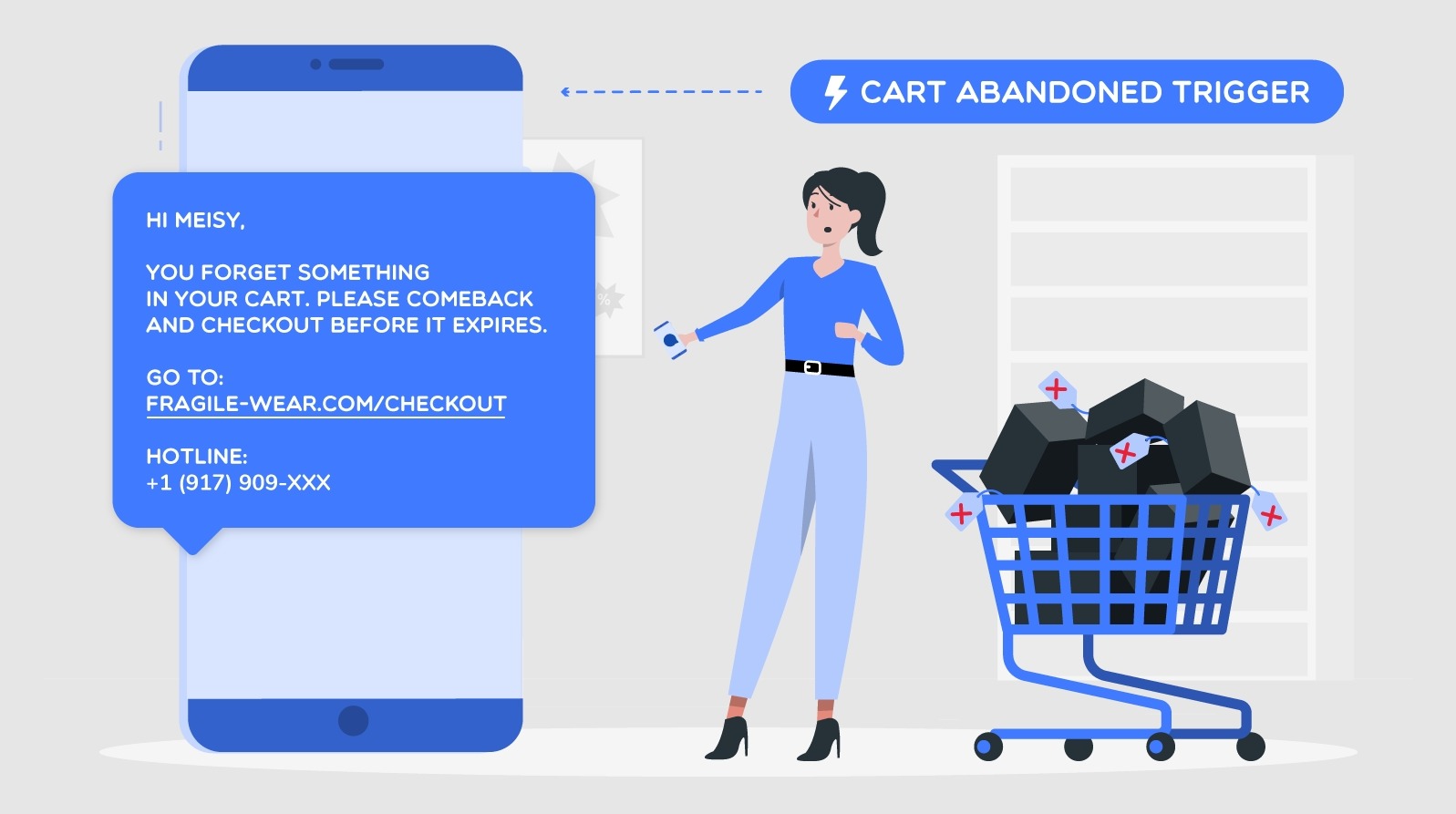
SMS automation or text message automation is the automatic triggering or sending of text messages to individuals or groups of consumers with little or no manual intervention. They’re pre-written, automatically scheduled, and get sent to a recipient at a specific time and date. This creates a more timely and personalized connection with a company’s contacts.
SMS automation is no stranger and has become increasingly popular with more companies as it allows them to save time by scheduling text messages to be sent in preset times. With it, companies can communicate promotions, special offers, updates, alerts, and purchased product information to inspire buyers to take action. Text messaging platforms also provide various automation methods like scheduling, dripping, or auto reply triggering for mass SMS campaigns.
Industries that should use SMS automation
SMS automation has delivered excellent results across many industries around the world. It’s safe to assume that you can benefit from including SMS automation in the marketing strategy as long as your company’s selling a product or a service. That said, these specific industries appear to benefit from SMS automation the most:
-
eCommerce: No surprise here since many online merchants have seen great results thanks to easy implementation of SMS automation. Combined with email marketing, eCommerce companies have powerful tools to recover abandoned carts, cross-sell, upsell, reply to customer messages, promote sales, offer exclusive offers, get reviews, and more.
-
Real estate: Real estate companies can use SMS automation to notify buyers about open houses, showings, estate sales, and much more. A drip SMS campaign can connect customers with realtors and send reminders to prospects.
-
Restaurants: As mentioned, SMS automation offers an easy tool to keep track of orders and communicate with customers about menu items, weekly specials, or time-bound promotions.
-
Gyms: Gym and fitness clubs can keep up and check in with customers through SMS automation. Additionally, SMS automation can encourage customers to renew their membership subscriptions. The industry has been massively hit by the pandemic, but online and virtual training is rising in popularity.
-
Education: Many schools use SMS automation to contact students and parents or communicate about holidays, emergencies, meeting reminders, financial aid programs, etc. Online schools can send SMS reminders about assignments and other necessary information.
-
Salon & wellness: Salon owners can encourage customers discounts on slow days, send appointment reminders, and follow-up messages to one-time users.
7 Types of SMS automation
There are many different SMS automation campaigns that business owners can use to improve work efficiency and generate more revenue. In this section, let’s see the most popular types of SMS automation:
1. Automated SMS workflows
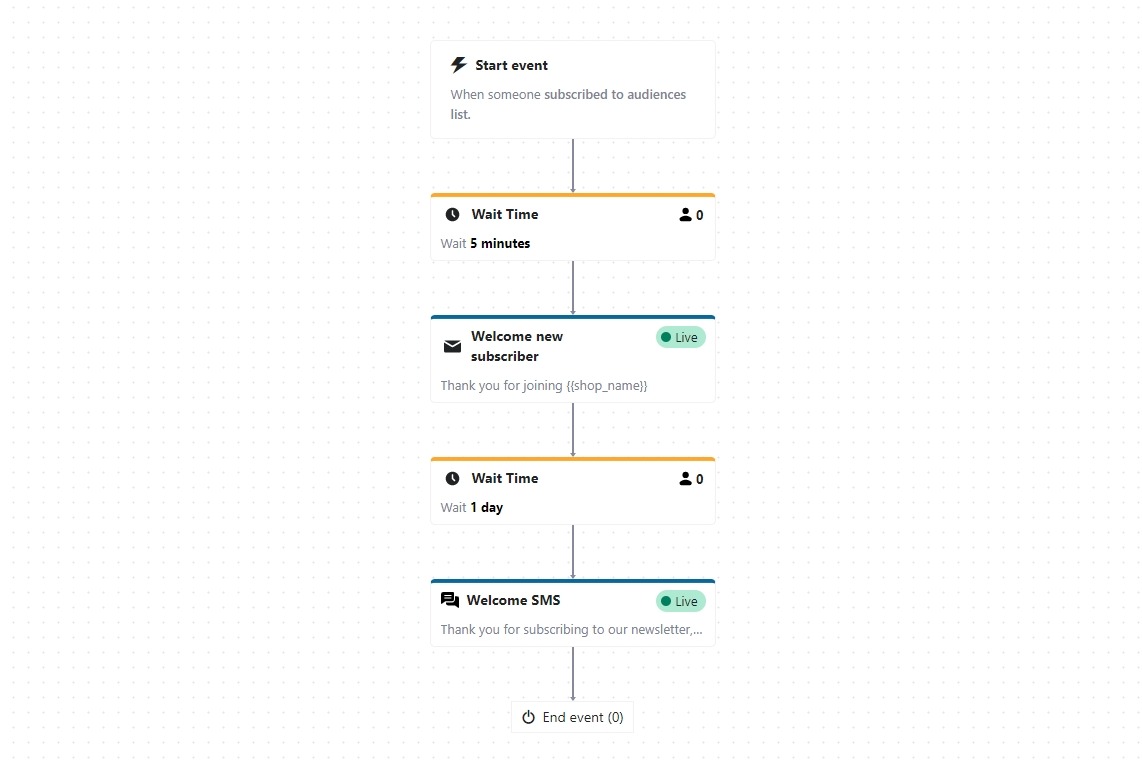
SMS workflows are automated sequences for subscribers to create a personalized experience for each customer. With SMS workflows, you can send automated text messages that have tailored message content based on the individual’s behaviors.
For example, you can send an SMS with a coupon link and then follow up after a period of time with another SMS based on whether or not they clicked on the link. These SMS workflows are perfect for collecting information, nurturing existing customers, and more.
With AVADA Email Marketing, you can build automated SMS workflows simply by dragging and dropping objects onto a blank canvas while connecting all events together. No coding required. Your marketing strategy is incomplete without an SMS automation feature.
2. SMS drip messages
SMS drip messages are text messages that are automatically sent to subscribers after a specific amount of time of an event.
With this feature, you can “set it and forget it” about SMS automation. With an SMS drips campaign, you can chain several campaigns together to make a series of automated SMS messages that are sent to customers days, weeks, or months after they initially engage.
For example, if you can follow up with a subscriber 5 days after they give you the phone number and ask if they would like a discount code to start buying.
SMS drip messages can be even smarter by applying segment filters - sending automatic text messages matching specific criteria that you specify. Some examples are subscribers who provided their names, clicked on a link, or made a purchase.
This is very powerful since you can be as simple or complex as you like to automatedly serve customers better with SMS messages.
3. SMS autoresponders
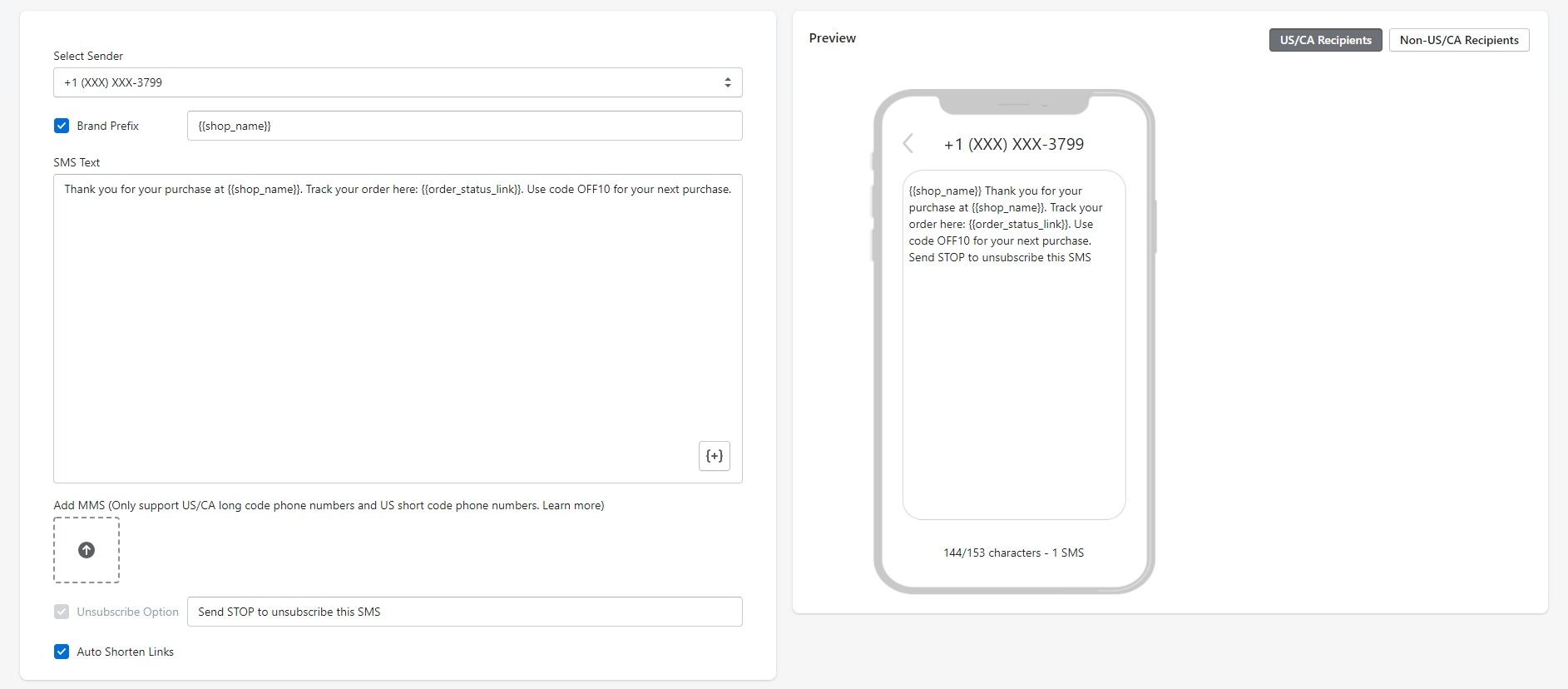
SMS autoresponders, or auto replies, are the most common SMS automation feature - which is an automated text message that is triggered when an event happens or a person texts a unique code. These SMSs are fully customizable and are sent immediately when your preset event happens.
SMS autoresponders are typically used to confirm orders or subscriptions. When someone buys from your store, they receive an auto reply text that thanks them for purchasing and provides some additional pieces of information. Some companies also use SMS autoresponders to purely provide information and set up other keywords that can deliver specific responses to consumers seeking info on certain things.
For example, when a customer text SHIPPING, you can set an SMS autoresponder with a link for customers to check their order’s delivery status on their smartphones.
4. Scheduled SMS messages
Scheduled SMS messages is one of the easiest ways to use SMS automation for your company. When composing a text message, you can choose to send it now, after a certain time period, or on a regular basis. By choosing the time to send it later, you can specify a date and time at which you want to send your text message.
For the best result, you should choose the timezone your messages should be scheduled to send in. With scheduled SMS messages, you can send event reminders, stock replenishment alerts, appointment reminders, and so much more. It’s a must have feature for SMS automation when sending mass text campaigns.
5. Abandoned cart SMS
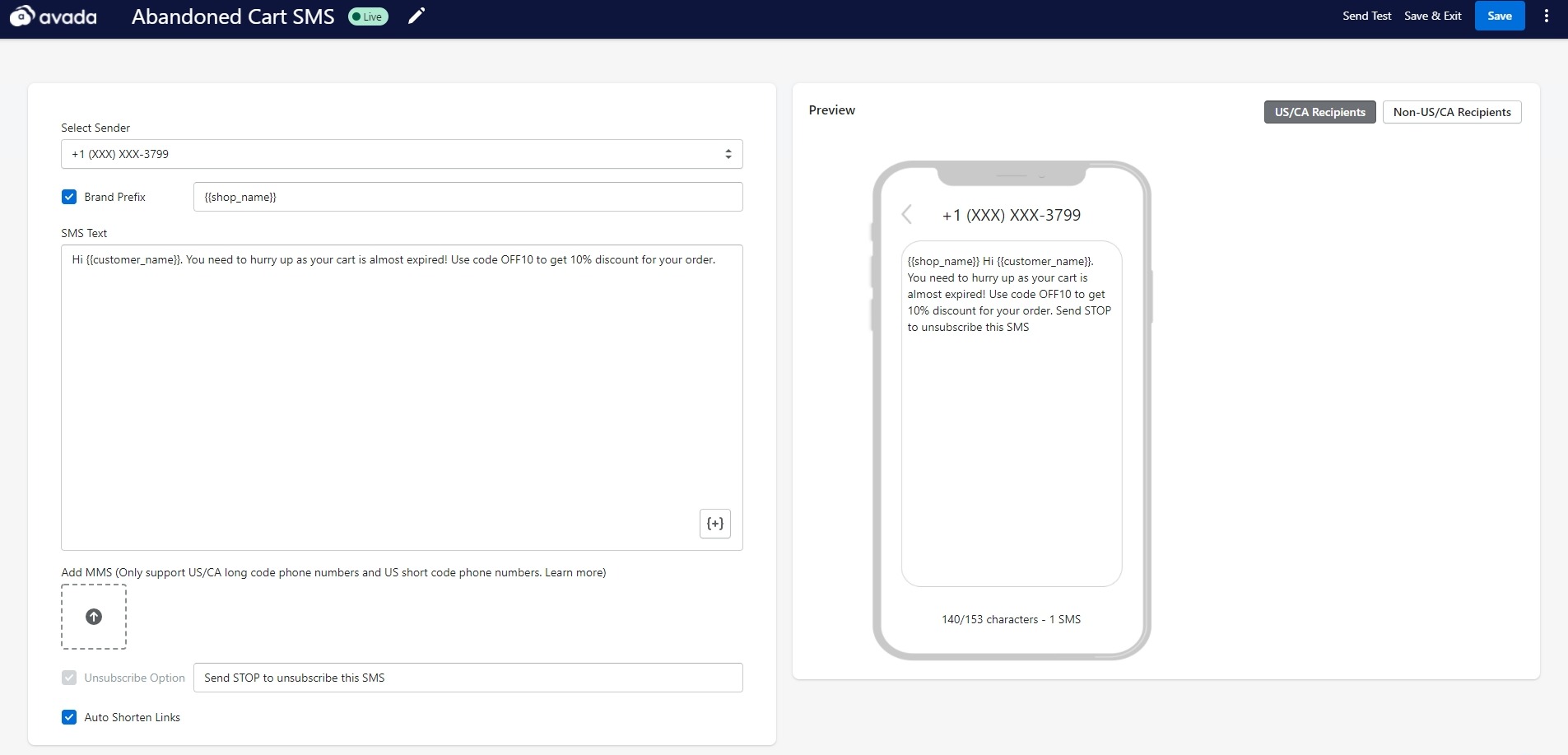
If you are the owner of an online store, you are probably concerned about how much revenue you miss due to abandoned orders. People often fill up their shopping carts with items, start the checkout process and then get distracted just to not complete their purchases.
SMS messaging has proved to be one of the efficient ways to re-engage with lost customers, bring them back to the carts and drive them to complete the purchases.
AVADA Email Marketing lets you send abandoned cart SMS with easy set up and 100% automation. Your automated text messages will start sending out to prospects who leave your checkout flow with a convenient link that brings them back to shopping.
You can then view your cart recovery SMS’s performance from our analytics dashboard. You’ll have access to all necessary data to make sure you’re making a positive ROI.
6. Recurring SMS messages
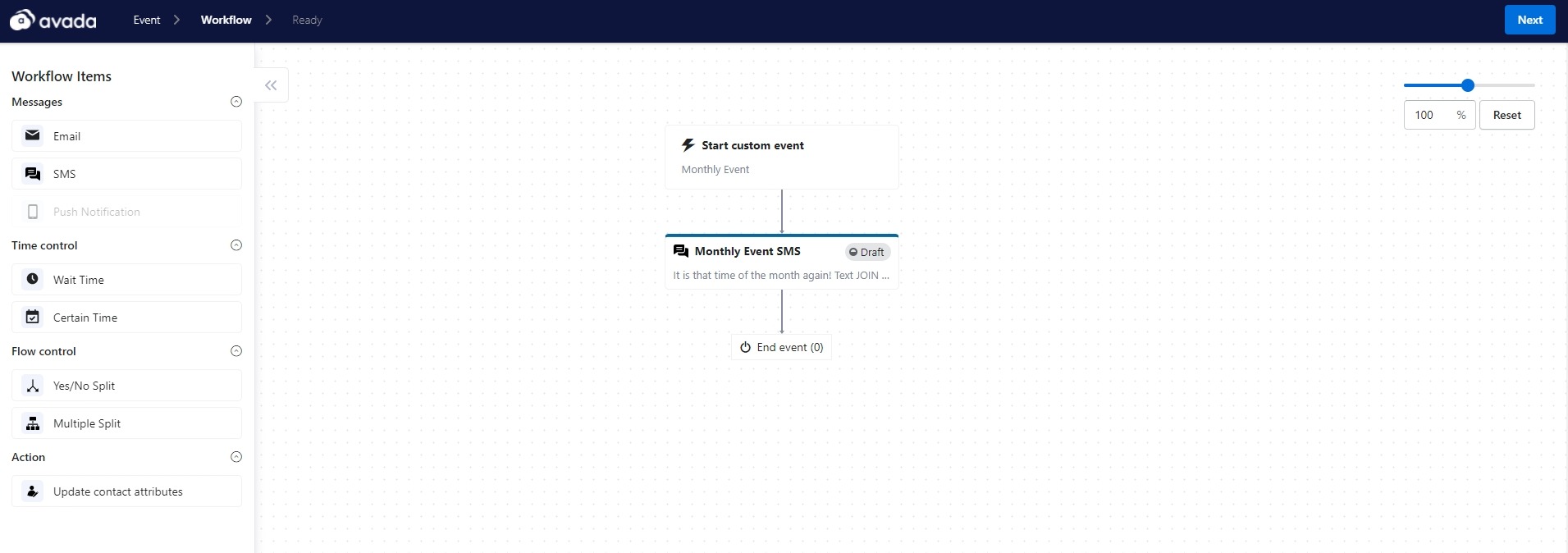
Recurring SMS or repeating messages are SMS texts that send automatically at regular timing. Similar to scheduled SMS messages, recurring SMS messages allow you to specify a time to send the message but additionally, you can choose to repeat sending the text in the future or not.
With this type of SMS, you can set up text messages to send daily, weekly, monthly, or annually. You have unlimited scheduling options to have the flexibility and put recurring SMS messages on autopilot.
As an example, you can set up a bulk text message that sends to your subscriber list on the second Tuesday of every month, at 8:15 AM to remind them about a monthly event. The options are endless. You can combine these messages with your segments to target people who meet specific criteria with relevant SMSs.
7. Automated birthday SMS
Automated birthday SMS messages are one of the fun and personal ways to engage with the customers or audience using text messages. This feature lets you send text messages on or a specific day to congratulate your subscribers’ birthdays and invite them to shop. You can also set the campaign and forget it to earn great value while putting in little effort.
How to start using SMS automation
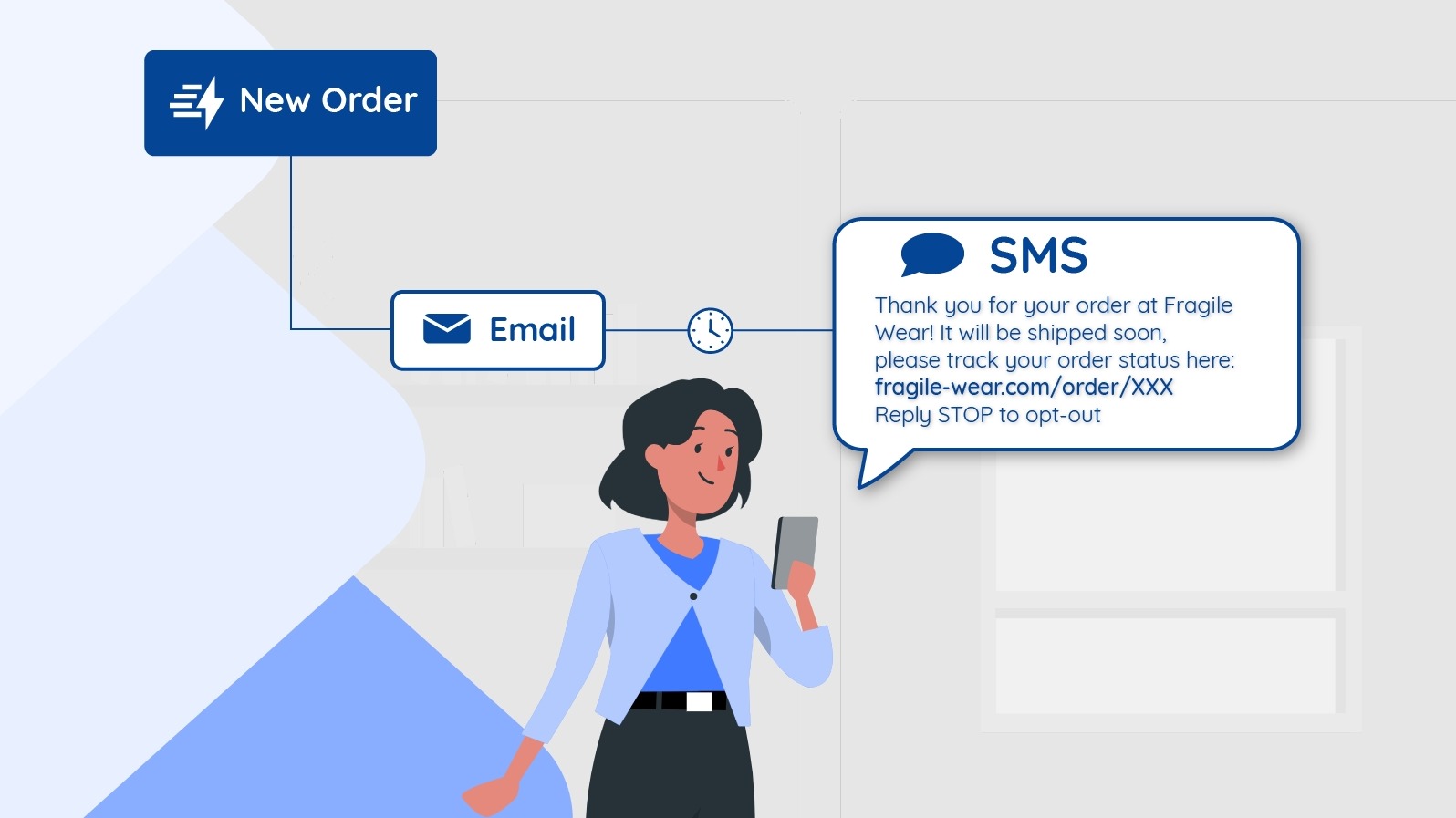
As we just saw, there are tons of different ways that SMS automation can benefit your business.
Your SMS automation strategy will change to adapt the goals of your SMS campaigns. Your brands’ needs are different from others, so your SMS automation usage is certainly different as well. The best way to start using SMS automation for your company is by choosing a robust SMS tool that has all the features you need to fit any kind of strategy you have.
AVADA Marketing Automation is your obvious choice here, with every feature of SMS marketing tools designed to be dead simple to use, especially the automation features. You’ll love how quickly you can set up automated SMS campaigns and start running.
Make sure you start using our SMS app by building your subscriber list from the get-go with relevant keywords and SMS collection pop-ups on your website.
From there, do segmentation to divide your customers into groups and avoid a one SMS for all approach. Instead, only send SMS messages to consumers that you know are interested in buying from you, either based on online activity (like cart abandonment) or their purchase activity’s patterns (buying every 3 months.)
Don’t be afraid to get a bit more personal with SMS by offering two-way chat or direct customer support. The most talked-about brands use SMS to create a really innovative approach.
But remember that SMS has an imporessing open rate and click-through rate, but conversations can still go cold if you only use SMS. To keep the conversations going, it’s important to create a seamless approach by communicating through both SMS and email marketing. With AVADA Email Marketing, you can combine the power of SMS automation and email marketing to drive revenue for your business.
5 Best practices for SMS automation

You now have a few ideas of how to use SMS marketing for sending updates and information to your customers. You now even have a fantastic tool in hand to start using SMS automation. The natural next step is to learn about SMS automation best practices to get it right with your text campaigns and make sure your messages are relevant.
Here are the best practices for SMS automation that you need to know.
1. Get the recipients’ permission
Never send a marketing message without the recipient’s permission. If you send a text message without explicit consent, you may be violating the TCPA law and can be fined severely. Aside from that reason, the recipients will not like receiving messages from a storage company and are likely to opt out ASAP.
The real challenge is keeping the permission you’ve earned from subscribers. Do that by starting off with full disclosure: tell your recipients exactly what kind of text messages you are going to send to them.
On that note, you should include a way for recipients to opt out with every SMS message. Just like email, you should make sure your SMSs have an unsubscribe link, or they can text STOP to opt out. Sending SMS messages to consumers who don’t want them means nothing for you or your company.
2. Use an omnichannel approach
Omnichannel communication is a fantastic way to improve the conversion rate and customer retention. Your SMS automation efforts combined with other channels can deliver an even better result.
If you can successfully incorporate your SMS automation campaign with email marketing, web push notifications, Messenger, and other marketing channels, you are much likely to achieve marketing goals way faster.
3. Don’t send too many messages in a month
It’s advised that you don’t send more than four promotional SMS messages in a month. However, depending on specific situations you can exceed this limit. But whatever you try to do, keep the number of promotional SMS messages to a minimum so you don’t end up annoying or peppering your customers with too many messages.
4. Keep SMS messages short
You have just 160 characters for each SMS message to work with. So every word in your text must serve a purpose to truly convince the customers to take an action. Also, don’t forget to have a clear CTA text or link at the end of the message.
5. Always personalize whenever you can
Your recipients will have a much more pleasant user experience if you are able to personalize your SMS campaign messages, like addressing the audience by their first name or sending offers that are tailored to their previous shopping behaviors.
Text offers can also be more relevant by being based on location, or previous purchases. This approach helps build and maintain a personal relationship with your customers through text messaging.
Personalization also means thinking about the time your customers receive their SMS messages. Remember that many people enable their text message notifications on their phones. Which means that if your text message arrives at 4 am, it’s going to result in a very unhappy customer.
Examples of SMS automation
You can have all the best practices in the world with SMS automation, but without real life ideas to start, you are still at zero. Here are some examples of SMS automation with well-timed messages to make your life easier with text message marketing.
A birthday discount
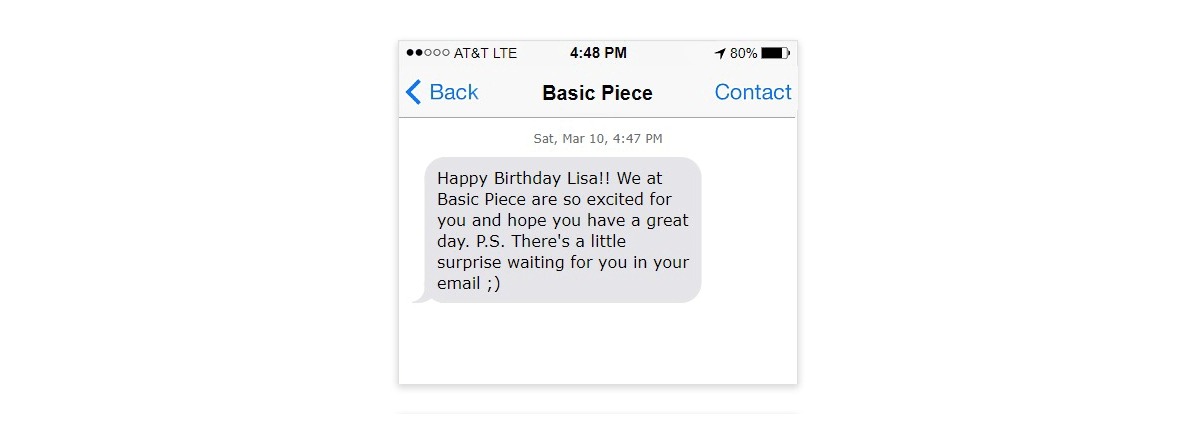
SMS automation is perfect for a special occasion, and the best possible occasion to celebrate is someone’s birthday. Show your dear customers that you care about them and send an offer that lasts a few days around their birthday.
You can put the offer directly in the SMS messages, or send it as a teaser and get the recipients check their email for a special birthday offer. Whatever you decide to do with this type of SMS automation, be sure to follow up with an email.
In the example above, you can see how Basic Piece sends a personalized birthday text message by calling out their customer’s name, while sounding informal like a friend. Then, they ask the customer to check their email inbox for a surprise gift from the company.
A cart abandonment message

Sending an abandoned cart SMS not only lets you connect with potential customers but also offers a CTA so the buyers can finish their order. Wodbottom found a way to make their cart abandonment message fun and joyful by including a dancing Brad Pitt to cheer the shoppers to go back to the cart and continue purchasing.
If your SMS service doesn’t allow sending GIFs or images, you can still find ways to make your SMS content fun with words and emojis.
An ask for review message
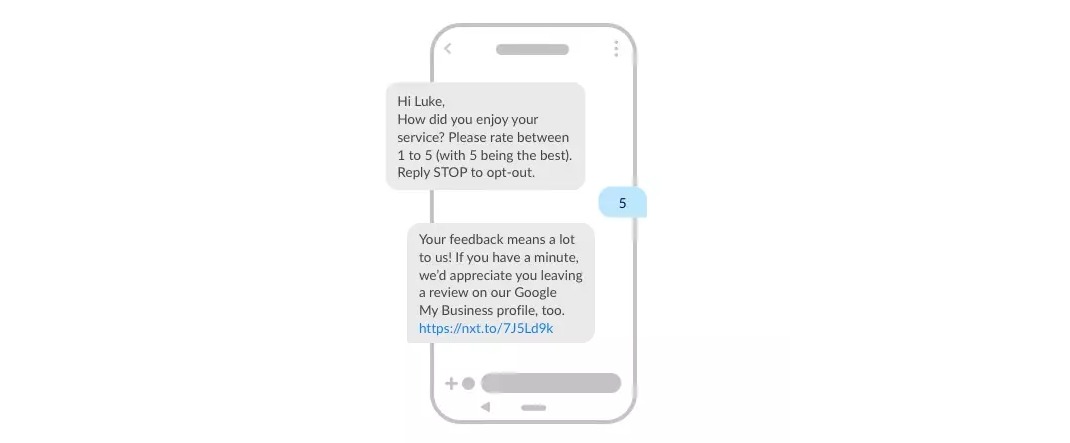
For many eCommerce businesses, getting feedback from customers makes a huge difference in how they take care of clients and improve the service or products. Nice reviews can encourage more brand’s growth via word-of-mouth, make a new buyer from someone seeing a bad review, and encourage repeat buying.
Be proactive by setting up SMS automated surveys to receive your customers’ opinions like in the example above. Don’t sound like a robot with your texts, add some personalization and thank them for their feedback. Also, you can encourage them to leave their stellar reviews on another site as well, especially if they already leave a great review through the SMS.
The best SMS automation tool

AVADA Email Marketing would be the obvious choice for the best SMS automation tool, even though it is a relatively new player on the market. With the app, you can follow up customers effectively with SMS automation, send SMS newsletter campaigns to win more sales, send SMSs to unlimited countries, and collect mobile numbers easily through opt-in forms.
A feature that I have to mention is the SMS automation feature, which provides pre-made workflows for you to combine the power of SMS marketing and email marketing to reach consumers in both media channels. With a 14-day free-trial, you would have more than enough time to test with SMS, so try to give the app a quick try.
Final words
Now is the time to start with SMS automation. Whether you want to launch a simple welcome series SMS messages or choose to follow up cart abandoned customers with personalized text messages - the possibilities to attract the consumer attention is endless with SMS marketing.
Your next step should be learning about the potential of SMS marketing and other possible usages, so jump right into these articles to learn more:
New Posts






